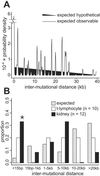The unexpected landscape of in vivo somatic mutation in a human epithelial cell lineage
- PMID: 11818556
- PMCID: PMC122209
- DOI: 10.1073/pnas.032655699
The unexpected landscape of in vivo somatic mutation in a human epithelial cell lineage
Abstract
Few data exist on somatic mutation in the epithelial cell lineages that play a central role in human biology and disease. To delineate the "landscape" of somatic mutation in a human epithelial cell lineage, we determined the frequency and molecular nature of somatic mutations occurring in vivo in the X-linked HPRT gene of kidney tubular epithelial cells. Kidney epithelial mutants were frequent (range 0.5 to 4.2 x 10(-4)) and contained a high proportion of unreported HPRT base substitutions, -1-bp deletions and multiple mutations. This spectrum of somatic mutation differed from HPRT mutations identified in human peripheral blood T lymphocytes and from germ-line HPRT mutations identified in Lesch-Nyhan syndrome or hyperuricemia patients. Our results indicate that DNA damage and mutagenesis may have unusual or mechanistically interesting features in kidney tubular epithelium, and that somatic mutation may play a more important role in human kidney disease than has been previously appreciated.
Figures


References
-
- Alberts B, Bray D, Lewis J, Raff M, Roberts K, Watson J D, editors. Molecular Biology of the Cell. New York: Garland; 1994. pp. 1138–1193.
-
- Martin G M, Ogburn C E, Colgin L M, Gown A M, Edland S D, Monnat R J., Jr Hum Mol Genet. 1996;5:215–221. - PubMed
-
- Colgin L M. Ph.D. thesis. Seattle: Univ. of Washington; 1997.
-
- Cole J, Skopek T R. Mutat Res. 1994;304:33–105. - PubMed
-
- Burkhart-Schultz K J, Thompson C L, Jones I M. Carcinogenesis. 1996;17:1871–1883. - PubMed
Publication types
MeSH terms
Substances
Grants and funding
LinkOut - more resources
Full Text Sources
Miscellaneous

